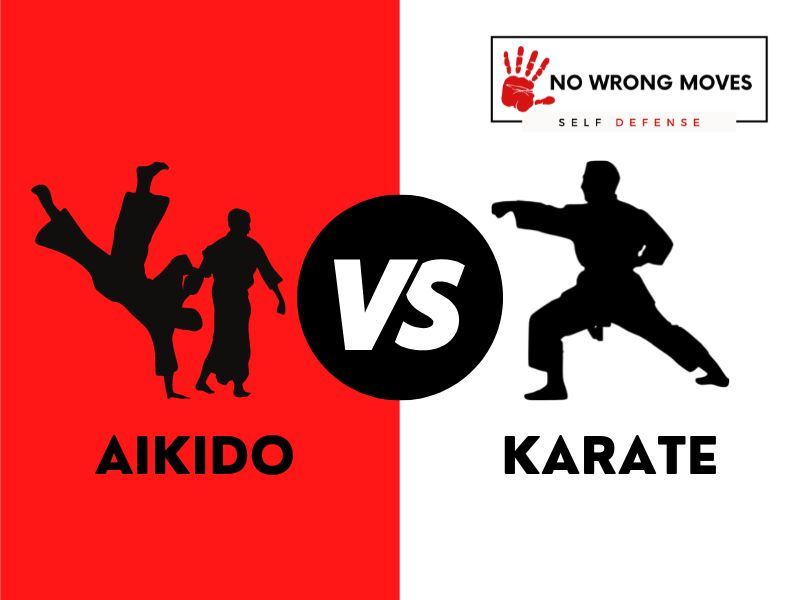
- What We Know About Aikido
- What We Know About Karate
- Key Elements Of Aikido
- Key Elements Of Karate
- Aikido Rankings & Levels
- Karate Rankings & Levels
- Aikido Vs. Karate Attire
- What A Typical Aikido Training Session Looks Like
- What A Typical Karate Training Session Looks Like
- Movies With Aikido And Karate
- Conclusion: Aikido Vs. Karate
Many people in the martial arts community debate whether Aikido or Karate is the better practice. While both offer unique benefits and principles, there are some key differences that set them apart.
The main difference between Aikido and Karate is what they focus on in self-defense.
Karate focuses on physical techniques of blocking and counterattacking, while Aikido's focus is on controlling and redirecting the attacker's energy to avoid or minimize injury.
In Aikido, practitioners do not compete or spar with each other. Instead, they train with cooperative partners to perfect their techniques. Karate, on the other hand, often involves sparring and competition.
In Karate, the ultimate goal is to perfect and master individual techniques. In Aikido, the ultimate goal is to develop and maintain a peaceful state of mind in order to effectively handle any situation.
Overall, while both martial arts emphasize self-discipline and physical fitness, Aikido focuses on harmony and conflict resolution, while Karate focuses on self-defense and individual strength.
But regardless, practitioners of both arts can benefit from training in the other to complement their skills and broaden their perspectives.
No martial art is inherently better than the other. At the end of it all, it's up to you, the individual practitioner, to set your own personal goals and preferences in your training.
What We Know About Aikido
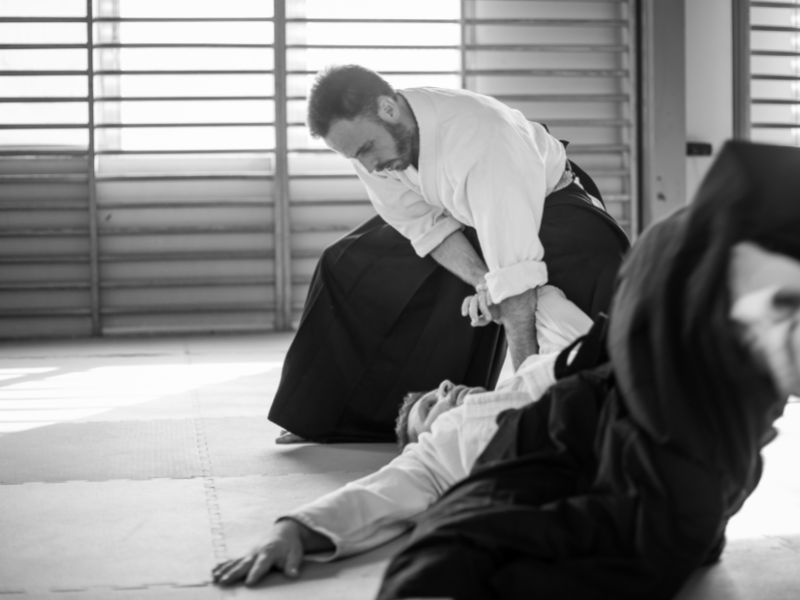
Aikido is a modern martial art that was created in the early 20th century by Morihei Ueshiba. It is based on the principles of budo, which follows the code of ethics of bushido.
Bushido is the code of ethics that samurai follow and teaches justice, courage, benevolence, politeness, honesty, honor, and loyalty.
Aikido is a combination of aikijujitsu, which is a martial art that uses both unarmed and armed fighting techniques, and iai-jutsu, which is a martial art that uses swordsmanship.
Aikido employs unarmed techniques, such as strikes, joint locks, and throws to subdue an opponent. It also makes use of weapons such as knives, swords, and sticks to defend against an attacker.
Aikido practitioners believe that one should only use the amount of force necessary to achieve their goals.
They also believe in using an opponent's momentum against them in order to control them rather than harm them.
Aikido is a challenging but rewarding martial art to study. It requires hefty discipline and dedication to master its techniques.
Thankfully though, the rewards are great for those who persevere, especially since Aikido can provide its practitioners with a sense of confidence and inner peace. It can also teach them how to better defend themselves and others in dangerous situations.
What We Know About Karate
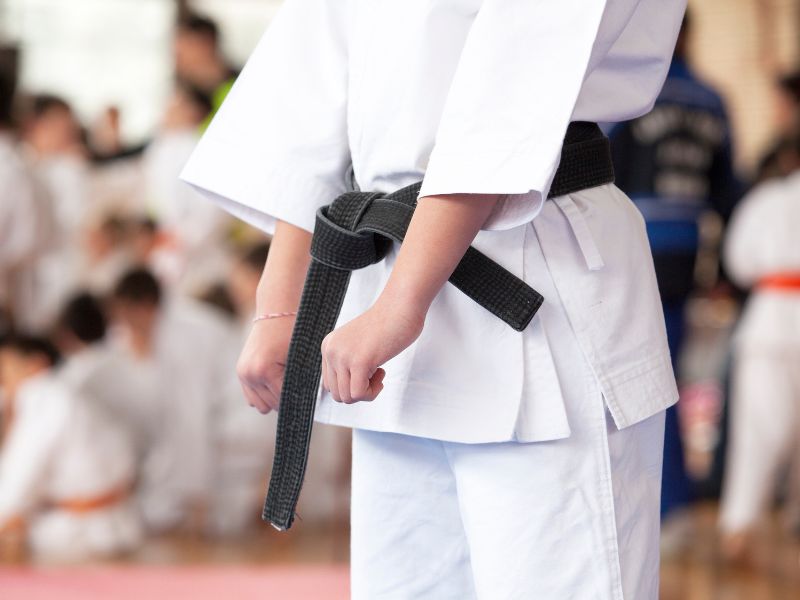
Karate is a martial art with its origins in India and China. The most popular tradition traces the origins of karate to the arrival of the Indian monk Bodhidharma in China.
He imposed the most severe discipline on the monks under him at the monastery of Shaolin, and they became famous for their physical prowess as well as their mental discipline.
The techniques of karate were introduced into the Ryukyu Islands in either the 15th or 16th century, and they continued to be refined over time.
During the Ryukyu Islands' history of tyranny, possession of weapons was forbidden for civilians, leading to an increased interest in unarmed combat.
Karate was eventually introduced to the public in Okinawa and then Japan, with Gichin Funakoshi becoming the supreme instructor of Karate-Do.
Funakoshi's systemized approach helped to codify and popularize Karate, leading to its spread throughout the world.
Today, Karate is practiced by people of all ages and levels of ability, from young children to seniors. It is an excellent way to improve fitness, flexibility, coordination, balance, and focus, while also learning self-defense skills.
Of course, this is only a brief history and understanding of Aikido and Karate, but if you want to go deeper into either art, be sure to check out the following posts:
Now, back to the comparison...
Let's look at the origins of the respective disciplines and then compare the key elements of their practices. You will be able to understand some of their similarities and differences a bit better afterward.
| Aikido | Karate | |
| Origins | Japanese | Okinawan |
Key Elements Of Aikido
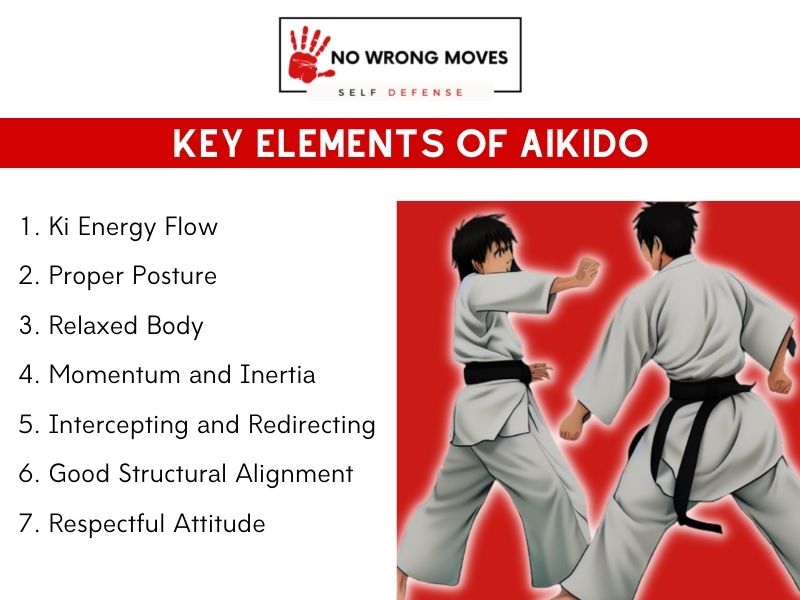
Aikido is a Japanese martial art that focuses on the proper stance and balance of the practitioner. Proper stance and balance are critical components of Aikido, as they provide the foundation for all other techniques.
A stable and balanced stance allows the practitioner to move fluidly and with control, making it easier to perform techniques effectively.
In Aikido, practitioners learn to redirect their opponent's energy rather than using force against them. Redirecting energy is one of the fundamental aspects of Aikido, and it's difficult to separate this idea from the sport itself.
Through properly redirecting an opponent's energy, Aikido practitioners can use their opponent's momentum against them, rather than relying on their own strength.
Apart from physical techniques, Aikido also emphasizes controlling one's emotions. Practitioners learn to remain calm and focused, even in stressful situations.
Aikido also places a strong emphasis on non-violent conflict resolution. The first option in any situation is to find a peaceful resolution, rather than resorting to violence.
Remember that in Aikido, the first option is not violence, and it reflects the overall philosophy of Aikido as a martial art focused on peace and harmony.
Key Elements Of Karate
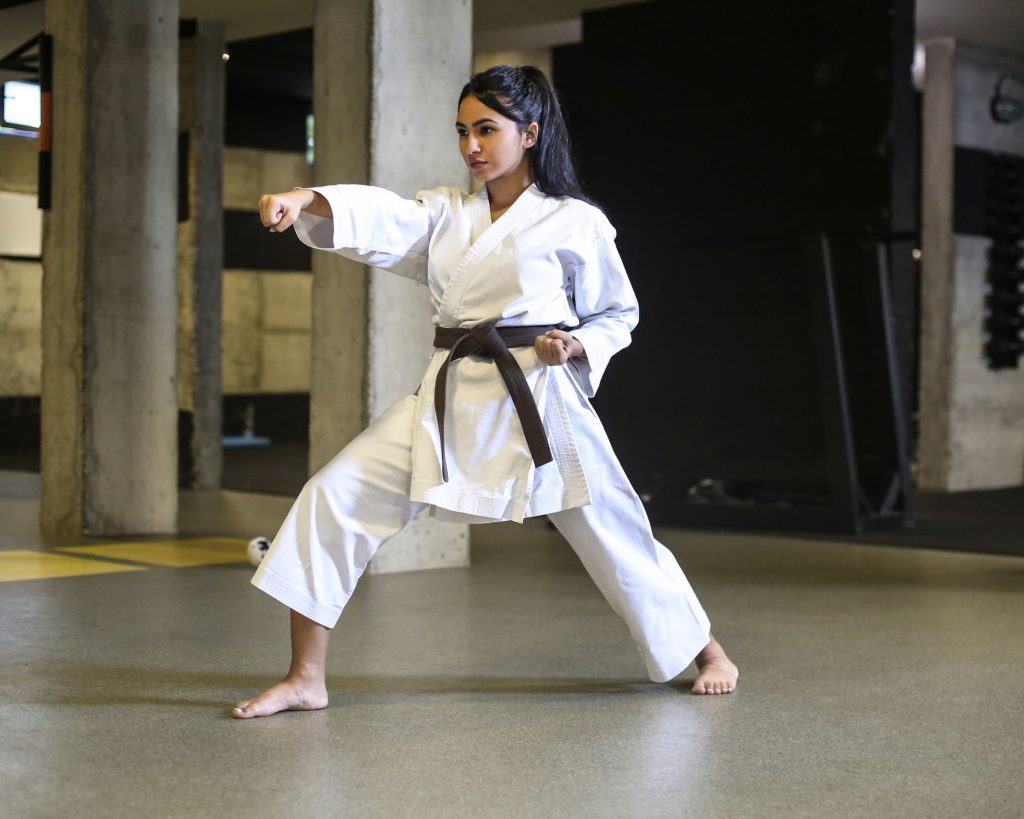
Karate is a martial art known for its striking techniques, especially which involve both punches and kicks--but there's more to it than just that.
Karate also includes grappling techniques, like takedowns and submissions, which can be used in conjunction with the striking techniques to take an opponent down and submit them.
Timing and distance are critical components of karate as well, allowing practitioners to execute their techniques with precision and effectiveness.
Balancing and positioning are also important, as they help ensure that the practitioner can maintain their stability while striking or grappling, and that they can control their opponent's movements.
Footwork is another essential element of karate, allowing practitioners to move fluidly and quickly around the mat. It also plays a significant role in timing and distance management, helping to position the practitioner in the optimal spot for executing techniques.
Power generation is the final key element of karate, as it involves the ability to generate force and momentum in one's techniques.
This is done through proper body mechanics, such as hip rotation, weight transfer, and breath control, which allow the practitioner to unleash powerful strikes and takedowns.
Together, these six elements form the foundation of karate and make it a complete and effective martial art.
Another thing I think is important to look at is the different rankings and levels in each art. if you are looking to take up either Aiki Jujutsu or Karate, whether as a hobbyist or to compete, you need to understand the different levels of proficiency and what is required for testing and ranking.
Another thing I think is important to look at is the different rankings and levels in each art. if you are looking to take up either Aikido or Karate, whether as a hobbyist or to compete, you need to understand the different levels of proficiency and what is required for testing and ranking.
Aikido Rankings & Levels
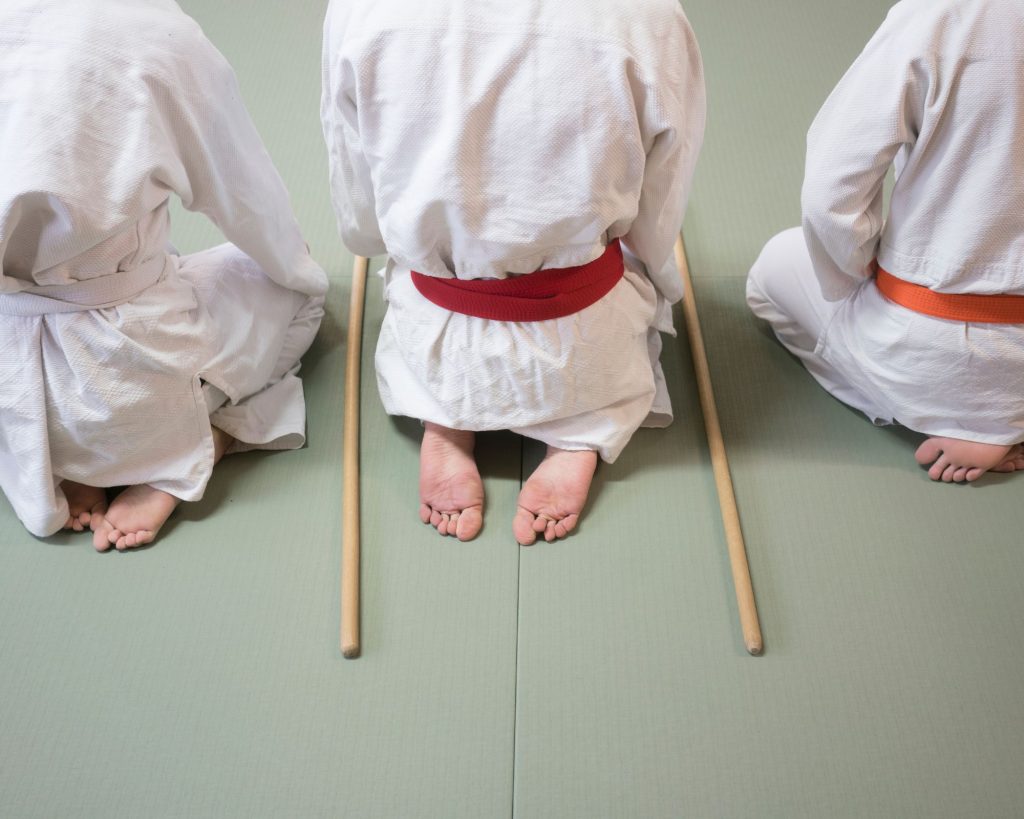
Aikido is a discipline that has many different levels, each represented by a different colored belt. The first level is white belt, which is for beginner students. Once you have mastered the basics of Aikido, you can move on to the blue belt, which is for intermediate students.
And finally, once you have mastered the art of Aikido, you can become a black belt, which is the highest level.
There are three degrees as a black belt holder: 1st dan, 2nd dan, and 3rd dan black belt. In order to achieve each of these degrees, you must pass a test that proves your mastery of Aikido.
There are also other ranks and colors that exist outside of the traditional ranking system. In some Western Aikido schools, there are more ranks added in between 1st dan and 2nd dan.
These ranks can be any combination of colors, and it allows for students to be promoted at a more gradual pace and helps to distinguish between students of different ranks.
Karate Rankings & Levels
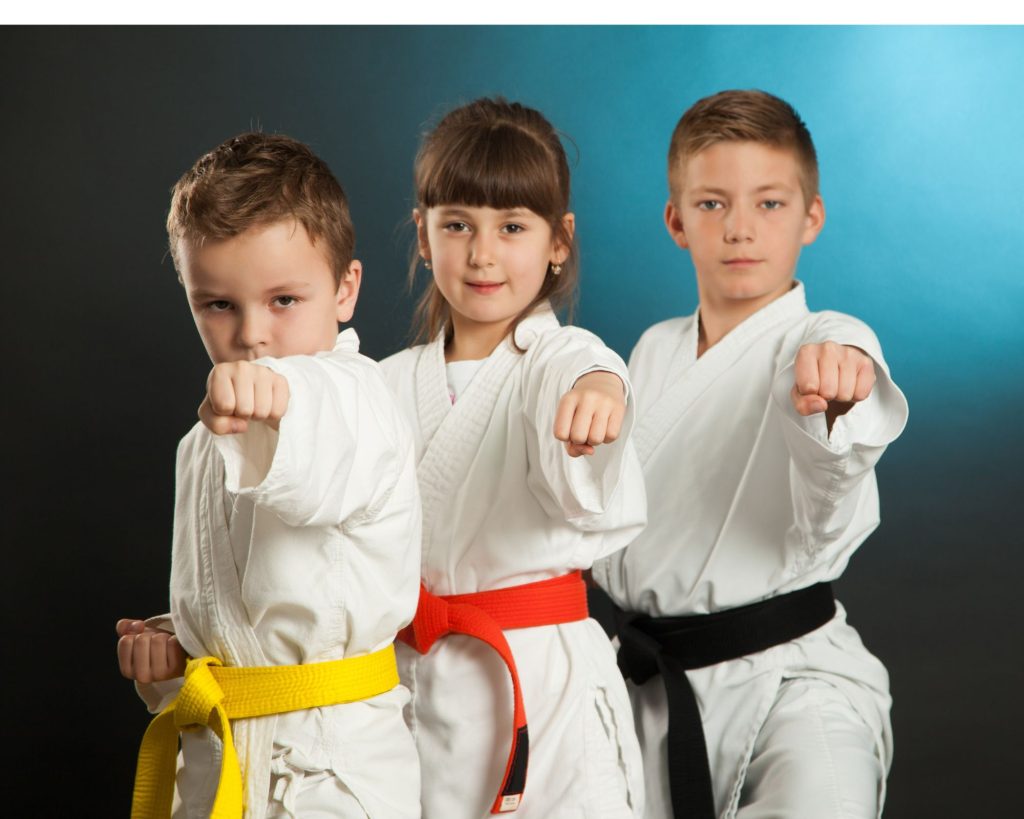
Karate Belts
The New Kyokushin Karate Belt System is a ranking system that consists of 10 kyu, or levels. There are 6 belt colors: white belt, orange belt, blue belt, yellow belt, green belt, and brown belt. All belts besides the white belt can have dashes to indicate further progress.
The purpose of the New Kyokushin Belt System is to acknowledge a student's progress and award them with a new colored belt when they have mastered the techniques and skills required for that level.
The New Kyokushin Belt System is divided into 3 sections: junior belts (white belt - orange belt), intermediate belts (blue belt - brown belt), and black belts.
In order to progress from one section to the next, a student must pass an examination that tests their knowledge of the techniques and skills required for that rank.
Junior belts must pass a White Belt Exam, intermediate belts must pass a Blue Belt Exam, and black belts must pass a Black Belt Exam.
The New Kyokushin Belt System is designed to be more challenging and progressive than the old Kyokushin Belt System. In the old Kyokushin Belt System, students progressed through the ranks by completing a set number of stripes on their belts.
This system wasn't very challenging or progressive, especially because it did not take into account a student's ability or level of mastery.
The New Kyokushin Belt System, on the other hand, is more challenging because students must pass an exam in order to progress to the next rank.
It's more progressive too, because students can better earn different belts by mastering different techniques and skills.
Karate Belt Examination Standards
Karate belt examinations and progression are an important part of the martial art. They are a way to measure a student's progress and ensure that they are learning material correctly. The minimum time limits between belt examinations are listed below.
- 10th Kyu to 3rd Kyu: Minimum 4 months between grades
- 3rd Kyu to 1st Kyu: Minimum 6 months between grades
- 1st Kyu to Shodan: Minimum 12 months between grades
- Shodan to Nidan: Minimum 2 years between grades
- Nidan to Sandan: Minimum 3 years between grades
- Sandan to Yondan: Minimum 4 years between grades
- Yondan to Godan: Minimum 5 years between grades
- Godan to Rokudan: Minimum 6 years between grades
These minimum time limits are just guidelines though, and they can vary depending on the individual's progress, ability, and commitment.
Remember that belt progression is not a competition or race. The main goal is to properly learn and master the techniques and skills required for each belt level.
It's better to take more time in between examinations if necessary, rather than rushing through the ranks without fully understanding the material.
Aikido Vs. Karate Attire
This section simply compares the clothing and uniforms that practitioners wear in combat.
Aikido Attire:
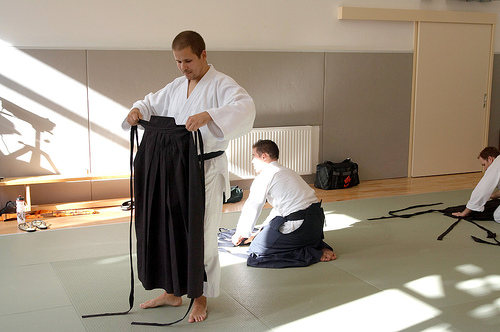
Most aikido practitioners wear a white dogi, or “uniform.” The dogi is a loose-fitting cotton kimono with a belt. In some schools, aikido students also wear hakama, which are pleated trousers that are tied at the waist and fall below the knee.
Male practitioners often don white tabi (socks), while female practitioners often wear white zori (wooden sandals). Some people also choose to practice without any clothes on in order to better feel their body and movements, but this isn't all too common.
Karate Attire:

Karate practitioners generally wear a gi, which is a type of uniform typically made of cotton or polyester. The gi pants have a tie string waist and the jacket has a round neck and long sleeves.
What A Typical Aikido Training Session Looks Like
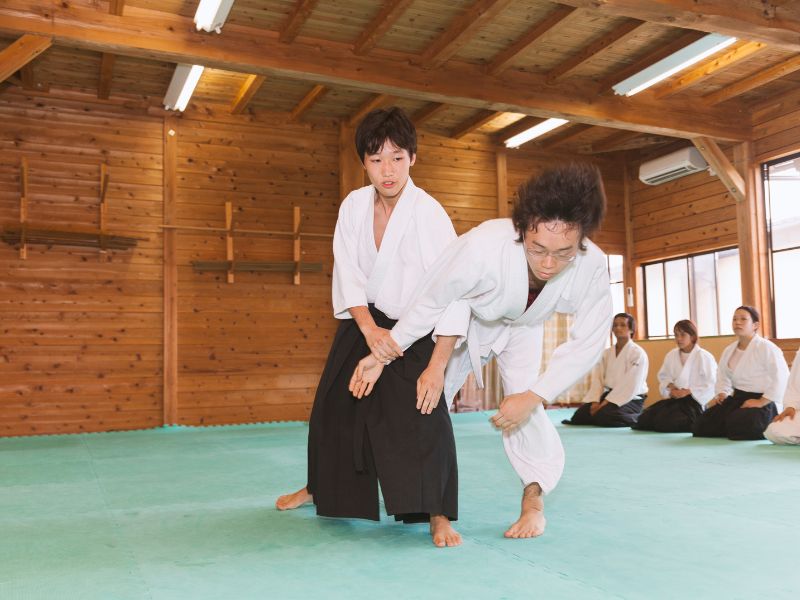
A typical Aikido practice session usually starts with a bow. This is a sign of respect for the dojo, the other students, and the instructor. The etiquette of aikido extends beyond just the bow, though. One must always be respectful, appreciative, and protective of all beings.
This attitude must be carried throughout the entire practice session.
Physical strain, whether during conditioning or in sparring against others, is part and parcel of Aikido. As such, practitioners need to maintain good manners and a positive attitude whenever they're in aikido class.
Aikido teaches you how to handle violence, but it still ultimately strives for peace, so never let your ego get in the way during your training.
Also remember that non-resistance is an essential element of proper aikido technique execution. Intercepting, deflecting, and redirecting an attack utilize the momentum and inertia of the attack.
Note that non-resistance does not mean being passively overpowered by the attack. But if you can avoid physical conflict, then you absolutely should.
It is also always important to maintain good posture and a relaxed body. Good posture includes maintaining your balance and keeping your center of gravity low. This helps you to be more aware of your surroundings and to respond more effectively to any situation.
Maintaining a relaxed body allows you to move more freely and makes it less likely that you will be thrown off balance by an attacker.
Similarly, be sure to focus on your breathing during aikido practice. This helps to calm and focus the mind, allowing for better decision making and execution of techniques.
Next, warm-up exercises are often done, including stretches and rolling or breakfalls (ukemi). These help to prepare the body for physical activity and prevent injury.
Following warm-ups, the instructor will lead the class through various aikido techniques and movements. These often involve practicing with a partner, called uke-nage (uke being the attacker, nage being the defender).
Practice with a spirit of cooperation, not necessarily competition. The goal is to mutually improve each other's technique and understanding of aikido principles, not to overpower or dominate the other person.
The practice session may also include weapons training, using a wooden sword (bokken) and wooden staff (jo). Weapons techniques often involve similar principles to those practiced with empty-handed techniques, but provide another layer of complexity and challenge.
What A Typical Karate Training Session Looks Like
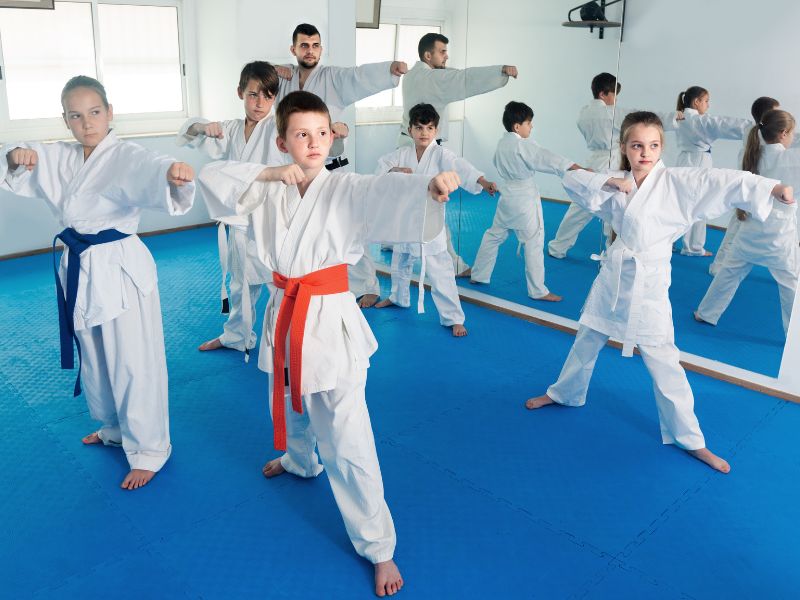
A typical karate practice class will begin with a warm-up. This may include some light calisthenics such as jumping jacks and running in place. The purpose of the warm-up is to get your heart rate up and to loosen your muscles.
The next part of the class will focus on technique. You will learn different punches, kicks, and blocks. The instructor will demonstrate the techniques and then you will practice them with a partner.
Sparring is another important part of Karate. Sparring is when two people fight each other using the techniques they have learned. This is done with protective gear such as gloves and pads.
Remember that Karate is not just about fighting. It is also about discipline and respect. At the end of each class, there is usually a period of meditation where you can reflect on what you have learned.
If the last few sections have been a bit full-on or a bit too technical, you will like this next section! Why? Because who doesn't love a good martial arts flick?
Both Aikido and Karate have been featured in a number of films and TV shows, so if you want to learn more about them, then entertain yourself with the following 👊
Movies With Aikido And Karate

These are some of the top movies and shows with Aikido in them:
- The Blind Swordsman: Zatoichi (2003)
- The Last Samurai (2003)
- Kill Bill: Vol. 1 (2003) and Kill Bill: Vol. 2 (2004)
- Street Fighter (1994)
- Ong-Bak: The Thai Warrior (2003)
- The Challenge (1982) TV series
Aikido can also be seen in popular shows such as:
- Daredevil (2015) TV series
- Arrow (2012) TV series
- Alias (2001-2006) TV series
- Chuck (2007-2012) TV series
- Xena: Warrior Princess (1995-2001) TV series
Some of the best movies with Karate in them, though you'll never guess from their titles, are:
- The Karate Kid (1984)
- The Karate Kid Part II (1986)
- The Karate Kid Part III (1989)
- Karate Girl (2011)
- Karate Kill (2016)
Conclusion: Aikido Vs. Karate
I hope you now have a deeper understanding of Aikido and Karate. In all truth, it is not about which discipline is "better" as they each have their pros and cons.
If you do plan on starting classes for either, please check out my other related posts, as I have tried my best to answer all the FAQs related to the art.
Feel free to share this post and any graphics you like, and of course, if you have any questions or thoughts, drop them below or shoot me an email, and I will be happy to assist 🙂
[author-box-jpx-fitness]
